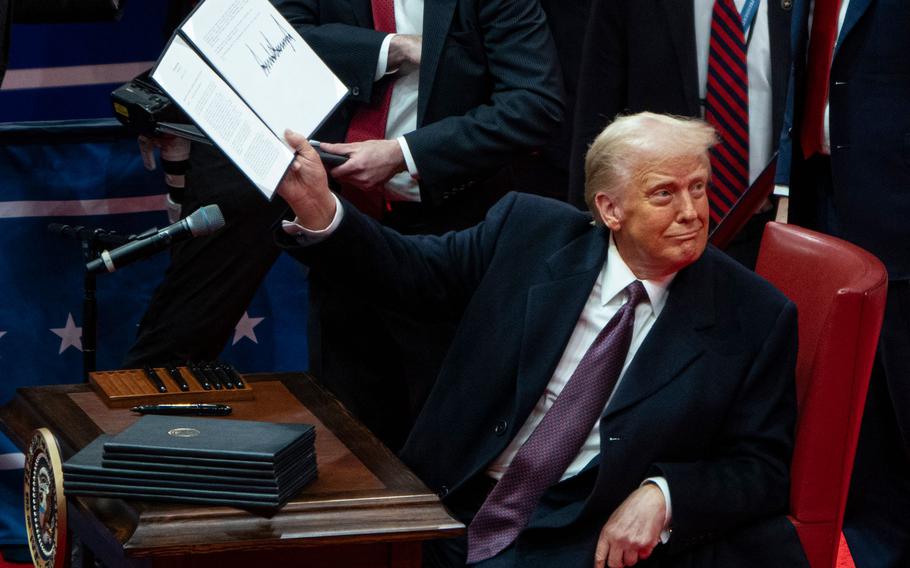
US President Donald Trump shows off an executive order he signed at an indoor Presidential Inauguration parade event at the Capital One Arena. (K.C. Alfred/San Diego U-T/ZUMA Press Wire/dpa/TNS)
The Trump administration is subjecting the U.S. constitutional system to a stress test. We’re on the treadmill, with instruments recording everything that’s happening.
Nearly every day since taking office, President Donald Trump has done something unlawful that makes the treadmill go a little faster. He has purported to ban birthright citizenship; fired 17 inspectors general; briefly frozen federal spending; and most recently, taken steps to shutter the U.S. Agency for International Development. That’s not counting the tariffs imposed on Mexico, Canada and China, which would probably-but-not-definitely be upheld by the courts as a lawful exercise of power delegated by Congress.
When these stressors are introduced into the system, the courts swing into action and block Trump’s executive overreach. Congress protests — or is supposed to — that the president can’t override federal laws that direct spending or establish agencies. If those things happen, the system equilibrates. Instead of degrading, the stress test shows the system works and what might need some fixing.
How long will the stress test continue? No one knows for sure. It’s been two weeks and Trump still seems able to come up with a headline-capturing power grab every day or two. What is certain is that the president can’t sustain this rhythm forever. At some point, Americans will demand that he start doing his main job, which is making the executive branch function.
If you’re watching Trump closely, as I am, your heart rate has probably been going up. Mine certainly has. That’s because the big question for our democracy right now is the same one that arises during any stress test: Will our heart hold out?
My bet is on survival. So far, Trump’s latest version of constitutional quasi-chaos hasn’t swamped the system. I’m tempted to suggest that we try to manage our anxiety, even as we keep running harder. Anxiety, after all, can also raise your heart rate.
Consider what’s happened so far. The president can’t change the Constitution, so Trump’s executive order claiming to roll back birthright citizenship is beyond his power. A court has already said so, blocking the order from going into effect. Trump could appeal all the way to the Supreme Court, but it’s not going to make any difference. The high court is not going to announce a brand-new, made-up interpretation of the 14tth Amendment.
Should the fired inspectors general choose to sue for their jobs back, they would likely win on the grounds that the law requires the president to inform Congress before taking such action. That would be nice for the rule of law. But they might choose not to sue since all Trump would have to do is fire them again, this time giving Congress proper notice.
As for the ill-fated spending freeze, which also could have been done legally if Trump had given notice to Congress, a court blocked it within hours. Trump then folded and lifted it.
That brings us to USAID, a federal agency responsible for delivering humanitarian aid around the world. Trump can’t unilaterally shut down a federal agency created by Congress, as former senior White House lawyer Tess Bridgeman has pointed out. Money appropriated by Congress for specific purposes must be spent for those purposes under the Impoundment Act. Civil service employees can sometimes be let go from their jobs when there is a reorganization leading to a reduction in force; but that’s not what’s happened here — at least so far. If Trump doesn’t follow the law regarding USAID, there will be more lawsuits, which he will lose.
Those taking notice of all this systematic (and unnecessary) illegality are understandably concerned that Trump might ignore court orders. That would generally count as a constitutional crisis — the real thing, not the stress test. Yet Trump, who did not ignore court orders in his first term, is unlikely to defy a judicial decision. The Supreme Court has six conservatives, three of them Trump appointees. The single worst thing he could do to alienate the justices would be to ignore a court order. No matter how conservative the justices might be, their primary identity comes from their role as interpreters of the Constitution and laws. They might tolerate a lot from Trump, but they won’t tolerate direct defiance of the authority of the judiciary.
Relying on Trump to act rationally might seem like a poor idea. Nevertheless, it’s worth remembering that the flurry of the last two weeks is intended to make headlines. Fear for the system can be combined with serious worries about the effects of Trump’s policies — all of which leads to panic and more headlines. For now, let’s take the stress test one burst at a time, and try to keep breathing.
Noah Feldman is a Bloomberg Opinion columnist. This column does not necessarily reflect the opinion of the editorial board or Bloomberg LP and its owners.